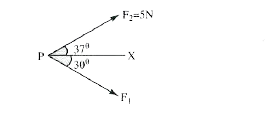A particle moves under force F=5(x−2)3 .Motion of the particle is
Translatory
Oscillatory
SHM
All of these
The correct Answer is:2
To determine the type of motion of a particle moving under the force F=5(x−2)3, we can analyze the force equation and compare it to the standard forms of motion.
1. Identify the Force Equation:
The force acting on the particle is given by:
F=5(x−2)3
2. Analyze the Form of the Force:
The force can be expressed in a general form:
F=k(x−a)n
where k=5, a=2, and n=3. Here, n is an odd number.
3. Determine the Type of Motion:
- If n is odd, the motion can be oscillatory. However, for oscillatory motion, the force should typically be in the form F=−kx or F=−k(x−a) which indicates restoring force towards an equilibrium position.
- In our case, the force is F=5(x−2)3, which is positive when x>2 and negative when x<2. This means that the force does not act as a restoring force that pulls the particle back towards an equilibrium position.
4. Conclusion:
Since the force does not provide a restoring effect and is not in the form required for simple harmonic motion (SHM), we conclude that the motion of the particle is translatory.
Thus, the motion of the particle is translatory.
Final Answer:
The motion of the particle is translatory.
---
The force acting on the particle is given by:
F=5(x−2)3
The force can be expressed in a general form:
F=k(x−a)n
where k=5, a=2, and n=3. Here, n is an odd number.
- If n is odd, the motion can be oscillatory. However, for oscillatory motion, the force should typically be in the form F=−kx or F=−k(x−a) which indicates restoring force towards an equilibrium position.
- In our case, the force is F=5(x−2)3, which is positive when x>2 and negative when x<2. This means that the force does not act as a restoring force that pulls the particle back towards an equilibrium position.
Since the force does not provide a restoring effect and is not in the form required for simple harmonic motion (SHM), we conclude that the motion of the particle is translatory.
The motion of the particle is translatory.
Topper's Solved these Questions
- OSCILLATIONSBOOK - AAKASH INSTITUTE ENGLISHCHAPTER - OSCILLATIONSEXERCISE - ASSIGNMENT (SECTION-B )
25 Videos
- OSCILLATIONSBOOK - AAKASH INSTITUTE ENGLISHCHAPTER - OSCILLATIONSEXERCISE - ASSIGNMENT ( SECTION-C )
11 Videos
- OSCILLATIONSBOOK - AAKASH INSTITUTE ENGLISHCHAPTER - OSCILLATIONSEXERCISE - Try Yourself
86 Videos
- NUCLEIBOOK - AAKASH INSTITUTE ENGLISHCHAPTER - NUCLEIEXERCISE - ASSIGNMENT (SECTION-D)
10 Videos
- PHYSICAL WORLDBOOK - AAKASH INSTITUTE ENGLISHCHAPTER - PHYSICAL WORLDEXERCISE - ASSIGNMENT (Section-B)
4 Videos
Similar Questions
For a particle showing motion under forces F=−5(x−2)2 , the motion is
View SolutionA particle moves under the force F(x)=(x2−6x)N, where x is in metres. For small displacements from the origin what is the force constant in the simple harmonic motion approximation ?
View SolutionFor a particle showing motion under forces F=−5(x−2) , the motion is
View SolutionA particle with total energy E is moving in a potential energy region U(x). Motion of the particle is restricted to the region when
View SolutionUnder the action of a force F=−kx3 , the motion of a particle is (k=a positive constant)
View SolutionA particle of mass 2kg is moving on a straight line under the action of force F=(8−2x)N. The particle is released at rest from x=6m. For the subsequnent motion(All the value in the right column are in their S.I. units)
_E01_071_Q01.png)
View SolutionAccording to Newton.s second law of motion, resultant force on a particle is in the direction of acceleration of the particle. Two forcce F1andF2 are acting on a particle as shown in the figure. The acceleration of the particle is along X-axis. FInd the value of F1 (in newton)

View SolutionA particle moves along x - axis under the action of a position dependent force F=(5x2−2x)N. Work done by force on the particle when it moves from origin to x = 3 m is
View SolutionThe position of a particle moving on a stringht line under rthe action of a force is given as x=50t−5t2 Here, x is in metre and t is in second. If mass of the particle is 2 kg, the work done by the force acting on the particle in first 5 s is.
View SolutionA particle moves under the action of a force F=20ˆi+15ˆj along a straight line 3y+αx=5, where, α is a constant. If the work done by the force F is zero the value of α is .
View Solution
